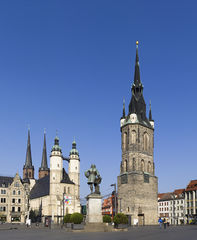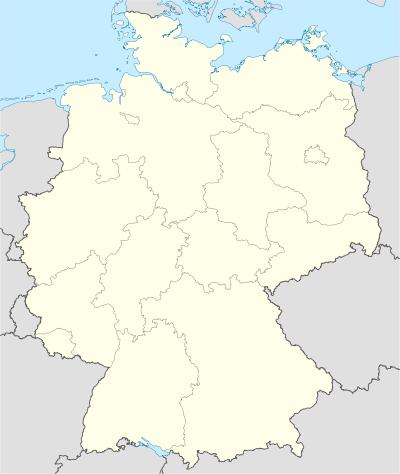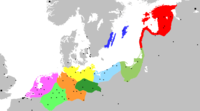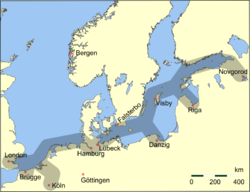Halle, Saxony-Anhalt
| Halle (Saale) | |
 |
|
.svg.png) |
|
 Halle (Saale)
|
|
| Coordinates | |
| Administration | |
| Country | Germany |
|---|---|
| State | Saxony-Anhalt |
| District | Urban district |
| Mayor | Dagmar Szabados (SPD) |
| Basic statistics | |
| Area | 135.01 km2 (52.13 sq mi) |
| Elevation | 87 m (285 ft) |
| Population | 232,323 (31 December 2009)[1] |
| - Density | 1,721 /km2 (4,457 /sq mi) |
| Other information | |
| Time zone | CET/CEST (UTC+1/+2) |
| Licence plate | HAL |
| Postal codes | 06108-06132 |
| Area code | 0049345 |
| Website | www.halle.de |


Halle is the largest city in the German State of Saxony-Anhalt. It is also called Halle an der Saale (literally Halle on the Saale river, and in some historic references simply Saale after the river) in order to distinguish it from Halle in North Rhine-Westphalia. The current official name of the city is Halle (Saale).
Contents |
Geography
It is situated in the southern part of the state, along the river Saale which drains the surrounding plains and the greater part of the neighboring Free State of Thuringia located just to its south, and the Thuringian basin, northwards from the Thuringian Forest. Leipzig, one of the other major cities of eastern Germany, is only 40 km away.
History
Halle's early history is connected with harvesting of salt. In fact the name Halle may be derived from a Pre-Germanic word for salt ("hall"). The name of the river Saale also contains the Germanic root for salt, and salt-harvesting has taken place in Halle at least since the time of the Bronze Age (2300-600 BC).
The town was first mentioned in 806. It became a part of the Archbishopric of Magdeburg in the 10th century and remained so until 1680, when Brandenburg-Prussia annexed it together with Magdeburg as the Duchy of Magdeburg. In 1815 it became part of the Prussian Province of Saxony.
After World War II Halle served as the capital of the short-lived administrative region of Saxony-Anhalt, this was until 1952 when the East German government abolished its "Länder" (States). As a part of East Germany (until 1990), it functioned as the capital of the administrative district ("Bezirk") of Halle. When Saxony-Anhalt was re-established as a Bundesland, Magdeburg became the capital.
According to historic documents, the city of Halle has been a member of the hanseatic league at least since 1281.
Main sights
- Giebichenstein Castle, first mentioned in 961, is north of the city centre on a hill above the Saale river.
- Moritzburg, a newer palace, was built in 1503. It was the residence of the archbishops of Magdeburg, was destroyed in the Thirty Years' War, and was then a ruin for centuries; rebuilt in 1904. Today it is an Art Gallery.
- Esels Markt, first sqaure of Halle
- Roter Turm,(Red Tower), Campanile of the Marien Church and landmark of Halle, one of five towers of the city's famous silhouette, build from 1418 onwards and completed in 1503.
- Markt Kirche, Marien Church, Our Dear Ladies, 1529–1554, here two churches where combined the Getruden Church dating back to 11th.c and the Marien Church from the 12th. c
- Hausmannstürme, quarter for the family of the Türmer, part of the Marien Church
- Cathedral (Der Dom), a steepleless building, was originally a church within a Dominican monastery (1271).
- Roland, dating back 1161 made from wood, after an upraising in the city a cage was placed around it, a reminder of the restrictions.
- Botanic Garden Martin-Luther University Halle-Wittenberg, founded over 300 years ago, part of Garden Dreams
- Händel House, build in 1558 and birthplace of Georg Fridrich Händel, collection of historic music instruments.
- Graseweghouse,
- Saline, Museum dedicated of harvesting salt
- Citywall, parts of it
- Daily Farmers Market, at the Main Square, selling vegetables, fruit, fish, dairy, meat and bakery products
- Yellow line, which runs over the market square, it marks a geologically falt line, Hallische Verwerfung
- Stadtgottesacker, a renaissance cemetery, from 1557 onwards, similar to the Composanto in Pisa, Italy,
- Galgenberge, location of the Gallows from 14th c onwards till end of 18th.c
- Markschlösschen, Markt 13, Gallery and Tourist Information
- Ackerbürgerhaus , 11/12th c building, near Dom,
- Frankens Stiftungen
- Reichhardts Garden, Historic Parc, part of garden dreams (Gartenträume), in 1794 Johann Friedrich Reichardt(1752–1814) optained the "Kästnerische Gut", changed ownership several times, the city of Halle bought this parc in 1903 to give the wider public access,
- Klausberge,porphyr mountain, location of the chapel of the Klaus brothers, panorama view over the Saale Valley, Eichendorf-Bench
- Bischofs Wiese, part of Dölauer Heide, 35 graves dating back at about 2500-2000 B.C.- Neolithicum, Hunter and Gatherer
- Volkspark
- Halle Opera House
- Theater Komplex
- Steintor Bühne
- Peißnitz Isle
- Pestalozzi Park
- Gimmritzer Damm, horse racing
- Halle-Neustadt, most of it built in the 1960s, is situated in the west of Halle. The complex is an example of GDR socialist housing development, as well as an example of successful growth.
Industrial heritage
Salt, also known as White Gold, was extracted from four "Borns" (well-like structures). The four Borns/brine named Gutjahrbrunnen, Meteritzbrunnen, Deutscher Born and Hackeborn, were located around the Hallmarket (or "Under Market"), now a market square with a fountain, just across from the TV station, MDR. The brine was highly concentrated and boiled in Koten, simple structured houses made from reed and clay. Salters, who wore a unique uniform with eighteen silver buttons, were known as Halloren, and this name was later used for the chocolates in the shape of these buttons.
The Halloren-Werke, the oldest chocolate factory in Germany, was founded in 1804. Old documents are on display and a chocolate room can be visited at Delitzscher Street 70. The original "Halloren-Kugeln" are sold in a box of eighteen little pralines.
Within East Germany, Halle's chemical industry, now mainly shut down, was of great importance. The two main companies were Buna and Leuna, and Halle-Neustadt (Halle Newtown) was built in the 1960s to accommodate the employees of these two factories.
Science and culture
The University of Halle was founded here in 1694. It is now combined with the University of Wittenberg and is called the Martin Luther University of Halle-Wittenberg. The medical school there was founded by Friedrich Hoffmann. The university's botanical garden, the Botanische Garten der Martin-Luther-Universität Halle-Wittenberg, dates to 1698.
The famous Baroque composer George Friderich Handel was born in Halle in 1685, where he spent the first 17 years of his life. The house where he lived is now a museum and houses an exhibition about his life. To celebrate the composer, Halle stages an annual Handel festival every June.
The German Academy of Sciences Leopoldina is the oldest and one of the most respective scientific societies in Germany.
Halle accommodates Germany's oldest Evangelic Bible college, known as MarienBibliothek, with 27,000 titles.
In the past Halle was a centre of German Pietism and played an important role in establishing the Lutheran church in North America, when Henry Muhlenberg and others were sent as missionaries to Pennsylvania in the mid 18th century. Muhlenberg is now called the first Patriarch of the Lutheran Church in America. He and his son, Frederick Muhlenberg, who was the first Speaker of the United States House of Representatives, were graduates of Halle University.
The Silver Treasure of the Halloren is displayed occasionally at the Technical Museum Saline. It is a unique collection of silver and gold goblets dating back to 1266. The ancient craft of "Schausieden" (boiling of the brine) can be observed there too.
The Landesmuseum für Vorgeschichte houses the Nebra sky disk, a significant (though unproven) Bronze-age find with astrological significance.
Halle Zoo contributes to the EAZA breeding programme, in particular for the Angolan Lion and the Malaysian Tiger. Halle is also known for its thriving coypu (or nutria) population, which is native to South America.
Climate
According to the German Weather Survey, among the 50 largest German cities Halle is the second driest one with a mean annual precipitation of 481.5 mm (18.96 in).
Transport history
Ludwig Wucherer made Halle an important railways hub in central Germany. In 1840 he opened the Magdeburg-Halle-Leipzig line, completing a connection between Magdeburg and Dresden. In 1841–1860, other lines to Erfurt, Kassel and Berlin followed.
Halle’s trams have been running since 1891. See also Halle (Saale) Hauptbahnhof, the main railway station.
Notable residents
- Baroque composer Georg Friedrich Händel was born in Halle on February 23, 1685, and stayed 17 years.
- Georg Cantor worked as a professor at the university of Halle.
- Dorothea Christiane Erxleben of Quedlinburg (1715–1762) made her Doctor of Medicine in 1754 at the Medical Department of Martin Luther University (MLU).
- August Hermann Francke (1663–1727), Lutheran Pietist theologian at the University of Halle and founder of the internationally renowned Halle Orphan House complex .
- Ludwig Wucherer (1790–1861) was elected Councillor.
- Georg Listing (born 1987) bassist from the Magdeburg-based band, Tokio Hotel
- George Müller (1805–1898), coordinator of orphanages in Bristol, England
- Lyonel Feininger Painter who created several famous images in Halle, including Der Dom in Halle
- Reinhard Heydrich, one of the leading Nazis in World War II, was born in the town. He was seen as the successor to Hitler. Heydrich was assassinated by Czech partisans in Prague in 1942.
- Richard Bruno Heydrich, singer, composer, founder of the Halle Conservatory, and father of Reinhard Heydrich.
- Hans-Dietrich Genscher, a former Vice Chancellor and longest serving Foreign Minister of Germany, was born in Reideburg, which belongs to Halle today.
- Huguenots — French Protestants, around 700 people made Halle their home after fleeing prosecution in France.
- Fabian von Schlabrendorff (1907–1980) Lawyer, officer, judge and member of the German resistance.
- Classical composer Daniel Gottlob Türk was born in Halle in 1750, and was a professor at the University of Halle.
- Friedrich Daniel Ernst Schleiermacher was university preacher and professor of theology to the University of Halle, where he remained until 1807.
- Oswald Boelcke, World War I German Flying Ace, was born in 1891 outside of Halle.
- Friedrich Ludwig Jahn, theology student of University Halle 1796-1800, went into hiding and used a phorphyr cave along the river Saale at the Klausbergen, this cave later was known as the Jahn Höhle (Cave), not just known for his four F as in fresh, pious, happy and free(frisch, fromm, fröhlich and frei)
- Nickel Hofmann, mastermason, worked over thirty years in Halle, including the Market Church and the Composanto
International relations
Halle is twinned with:
References
- Notes
- Notes
- ↑ "Bevölkerung der Gemeinden nach Landkreisen" (in German). Statistisches Landesamt Sachsen-Anhalt. 31 December 2009. http://www.statistik.sachsen-anhalt.de/download/stat_berichte/6A102_hj_2009_02.pdf.
- ↑ "Twin towns". www.ouka.fi. http://www.ouka.fi/kansainvalisyys/english/ystavyyskaupungit.html. Retrieved 2009-11-07.
- ↑ Jérôme Steffenino, Marguerite Masson. "Ville de Grenoble - Coopérations et villes jumelles". Grenoble.fr. http://www.grenoble.fr/jsp/site/Portal.jsp?page_id=92. Retrieved 2009-10-29.
External links
- Official website
- Martin-Luther-University Halle-Wittenberg
- "A New Germany Rises", Time, September 12, 2004
- Site about Halle with many photos and descriptions in English
- Origins & Places of Interest (German)
- Tramway in Halle (English) (German)
|
|||||||||||
|
||||||||||||||
|
|||||||
|
||||||||||||||||||||||||||

